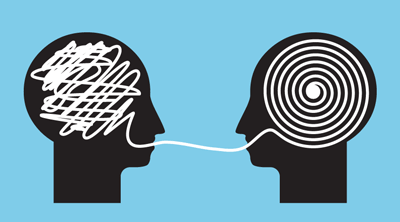Consultants, how can you use active listening to get better integrated at a client's ?
We are born with two ears and with one mouth so that we listen twice as much as we speak (Confucius)
What is active listening?
Developed by the American psychologist Carl Rogers, active listening consists in listening carefully and in a non-directive way, building trust, respecting and using empathy with the person you are speaking to so that they can express freely, without fear of judgement and without stress.

Click here for more information on active listening
How can this help as a consultant?
-
Beginnings at the customer
The arrival at the customer’s is a critical period for the consultant. As every newcomer, he or she has to rapidly integrate a lot of information. The status of consultant may put an additional pressure because the client is expecting productivity rapidly.
Therefore, beginnings are intense because the consultant has to immerse himself/herself in the project and often catch subtleties. To be sure to assimilate information correctly, the consultant should ask questions, reformulate and summarize aloud what was said.
Furthermore, the client should feel that the consultant is carefully listening to them. If the consultant doesn’t show any interest, feelings or emotion, the client will rapidly think that the consultant doesn’t care about the issue. To show interest, the consultant can try to make visual contact with his interlocutor and use nonverbal signs like a nod. This can create a climate of trust with the client and they will naturally be more inclined to interact with the consultant.
Active listening enables the consultant to identify the implicit and explicit objectives in order to be in line with his interlocutor and start the project in the right direction. The client will feel more confident if they feels they have been heard and understood.
-
During the mission
Teamwork:
In most cases consultants are part of a team. In that work team, it is essential to take the time to listen to what the members of the group have to say and show that their words are welcomed without systematically having to approve them.
Calling a colleague’s statements into question is sometimes necessary. Active listening, doesn’t forbid to have personal positions, but an appropriate reaction to deal with a contradiction could be used. For example, asking open questions could make the colleague feel more open to suggestions and compromise.
Example:
Antoine: On that machine, I have planned to test all the alarms that are set up.
Marc: I wouldn’t test all the alarms, we don”t have time to test each of them.
Antoine: What would it entail in terms of security, quality, regulatory if we did not test them all?
Thanks to this critical thinking and this smart way to communicate, the consultant will gain value in the eyes of their colleagues.

Meeting:
Holding or taking part in a meeting is part of everyone’s job, but it doesn’t always go as planned. For example, some people will use the meeting to talk about another subject. In this case, making eye contact or asking questions can make them come back to the subject at hand.
An active listener knows how to concentrate intensively on what their counterpart is saying and knows how to ignore other distractions (phone, computer…).
Moreover, if the members of the meeting feel they are listened, they will probably make an effort to express themselves clearly and communicate more information.
Disagreement/conflict:
Active listening can help solve disagreements and avoid conflicts.
The goal of the consultant is to satisfy the client but sometimes there are discrepancies between what the client ask and what the consultant was supposed to do. In this case, it is important to talk about it and not let misunderstandings get worse.
Listening actively and pay attention to the client’s body language could enable to understand their expectations and above all, identify what is implied when they are talking. Asking questions and reformulate leads to reveal unsaid things with caution and tact. It is by identifying the said and unsaid things about the disagreement that it will be possible to find effective solutions to the problem or a common ground.
Then the consultant should communicate precisely and positively and shouldn’t generalize or affirm assumptions or use negative turns of phrase.
Some turns of phrase that can be used:
|
Negative |
Positive |
|
You |
We |
|
You didn’t… |
It wasn’t possible to … |
|
I want… |
What do you think about… ? |
|
What you are asking for is impossible |
Some points are relevant but we should think about… |
|
You decision is unfair |
Your decision can be improved in terms of equity |
|
It’s forbidden/impossible |
Let’s analyze the possible solutions |
It is important for the consultant to have a good relationship with the customer, on the one hand to have suitable working conditions and on the other hand for his well-being. Active listening and positive communication will facilitate dialogue and solve disagreements without having to face a conflict.
The technic of active listening is very usefull in various professional situations (like we have just seen). But it can also be applied in many personal cases with friends or spouses to resolve or avoid conflicts or misunderstandings.